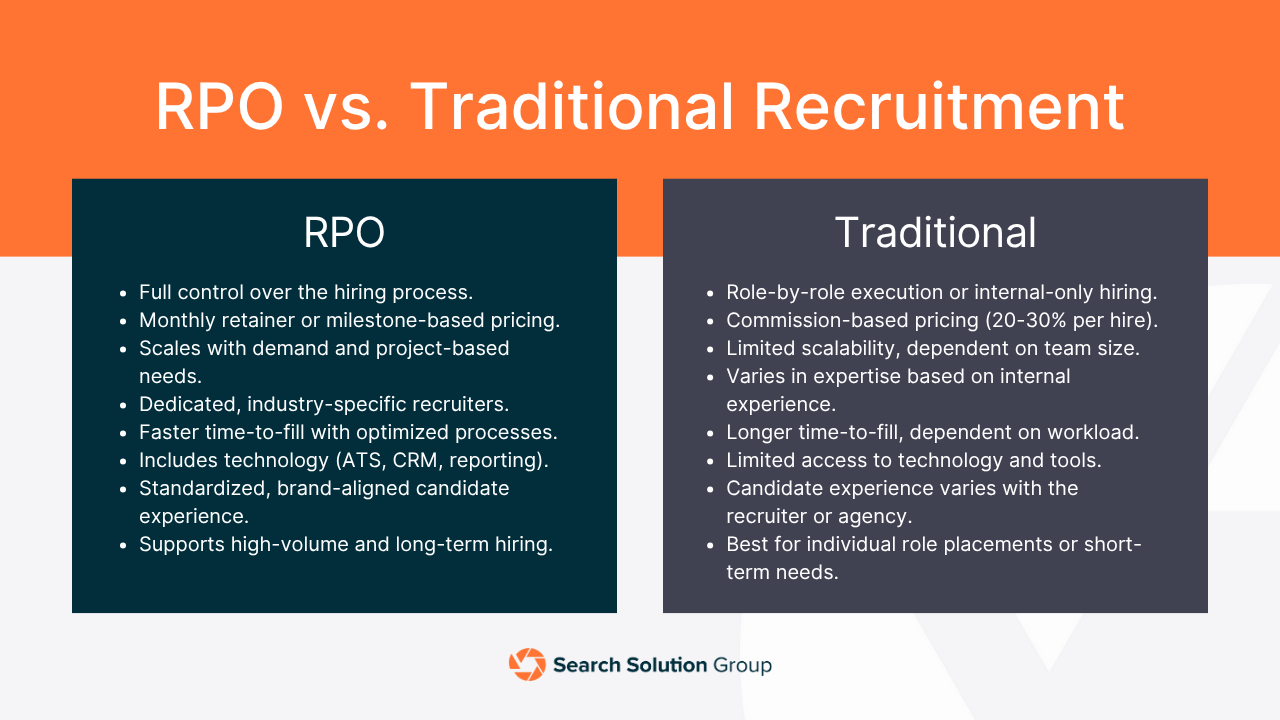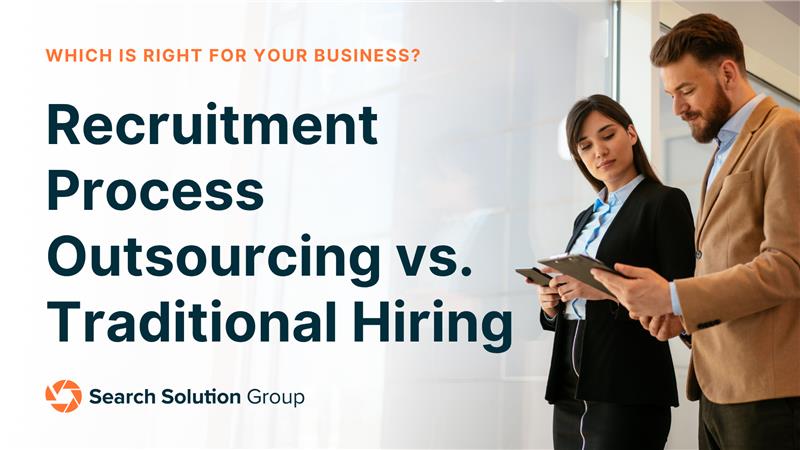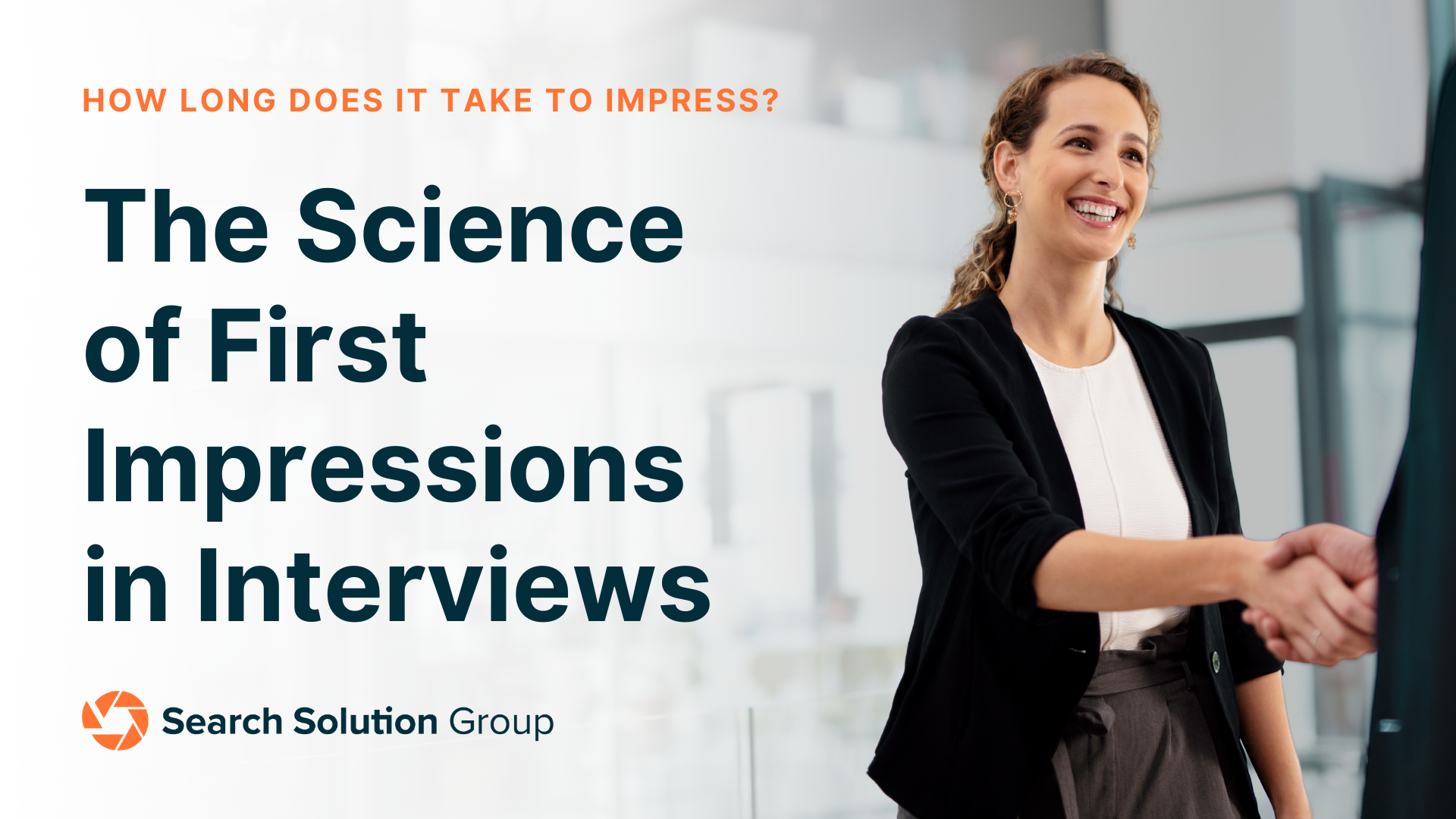Hiring great talent is a top priority for growing businesses, but how you hire can be just as important as who you hire. With multiple options available, from internal recruiters to external partners, it can be difficult to determine which hiring method best supports your goals.
Two commonly used methods are Recruitment Process Outsourcing (RPO) and traditional recruiting through internal teams. Each offers distinct advantages depending on your hiring volume, team structure, and long-term strategy.
In this article, we’ll break down what each model offers, when to use them, and how to determine which is the right fit based on your company’s size, growth stage, and hiring objectives. Whether you’re scaling fast or filling one key role, we’ll help you make a more informed hiring decision.
What Is Recruitment Process Outsourcing(RPO)?
Recruitment Process Outsourcing (RPO) is when an external provider takes over part or all of your company’s recruiting function. Instead of handling hires individually, an RPO partner operates as an extension of your team, bringing tools, technology, and strategy to elevate your hiring outcomes and drive better performance.
RPO services are highly customizable. They can manage everything from attracting talent and reviewing candidates to conducting interviews and making offers. The goal is to create a scalable, repeatable process that delivers high-quality candidates faster and more efficiently.
RPO is commonly used by companies experiencing:
- High-volume hiring
- Additional internal recruiting support
- A need for consistent employer branding
- Desire for improved candidate experience and analytics
Think of RPO as a fully integrated hiring solution that strengthens your internal capabilities. It’s a way to improve consistency, efficiency, and results across your entire recruitment process.
What Is Traditional Recruiting?
Traditional recruiting refers to either hiring done by your internal talent acquisition (TA) team. It is often effective for steady-state hiring when the volume is predictable and the team has the resources and time to manage open roles.
This model works well when:
- Hiring needs are minimal or project-based
- Budget is limited
- Your team has the resources to manage the process internally
Traditional recruiting is often more reactive, driven by immediate openings and timelines. While it may be appropriate in certain cases, it can lack the infrastructure, data, and process optimization that comes with a broader RPO strategy.
When to Use RPO
RPO is ideal when hiring is a strategic business function. It offers structure, support, and scalability for organizations experiencing rapid growth, frequent hiring, or increased complexity in recruitment.
Consider RPO when:
- You’re in hyper-growth mode or planning a large hiring initiative.
- Your internal team is stretched thin or lacks specialization.
- You want a standardized, branded, and consistent hiring experience across departments or locations.
- You’re looking for strategic hiring support, not just resume delivery.
- You need to reduce time-to-fill or improve retention metrics.
RPO partners can also help you integrate better technology, improve diversity hiring, and introduce advanced metrics into your process. It’s especially valuable for companies planning to hire 30+ roles annually or dealing with seasonal or unpredictable hiring surges.

Benefits of RPO Services
Recruitment Process Outsourcing isn’t just a temporary fix; it’s a long-term hiring strategy that brings structure, consistency, and measurable improvement to your talent acquisition efforts.
Here’s how businesses benefit when they adopt an RPO model:
- Fewer Delays, Faster Hires
Dedicated resources and optimized workflows speed up the recruitment timeline, helping you secure top talent before competitors do. - Higher-Caliber Candidates
RPO teams bring deep sourcing expertise and advanced tools that elevate the quality of your talent pool across every role. - Built-In Flexibility
Whether hiring slows or scales up, RPO adjusts with your business. It’s designed to accommodate evolving headcount needs without sacrificing performance. - Unified Hiring Experience
A single strategy across departments ensures every candidate touchpoint reflects your culture, values, and brand identity. - Actionable Reporting & Metrics
Gain full visibility into your hiring process through real-time data on performance, pipeline health, and process bottlenecks. - Better Long-Term Retention
Strategic sourcing, improved screening, and consistent onboarding contribute to stronger employee fit and reduced turnover. - Internal Team Relief
By outsourcing the heavy lift, your in-house team can shift focus to employee engagement, workforce planning, and organizational growth.
When Traditional Recruiting Might Be Enough
Not every business needs a full-scale RPO solution.
Traditional recruiting still makes sense when:
- You’re hiring for only a few roles per year
- You have budget constraints or only need short-term help
- Your internal recruiters are performing well and have capacity
- You’re looking for project-based or temporary hires
This model can be more cost-effective in the short term and often works well for startups or small businesses that want flexibility without a long-term commitment. However, it’s important to monitor time-to-fill, candidate quality, and recruiter workload to ensure this approach is still meeting your business needs.
Questions to Help You Decide
Not sure which path is right? These five questions can help you assess your readiness:
How many roles are we looking to fill this year?
High-volume or continuous hiring may justify the investment in an RPO.
Do we need help with niche or hard-to-fill positions?
RPO teams often include specialty recruiters experienced in complex or technical roles.
Is our internal team meeting current hiring demands?
If hiring is falling behind or quality is suffering, external support could help.
Are we searching for long-term, strategic support?
RPO offers more than recruiters—it includes processes, tools, and metrics.
Could our recruitment process be more effective?
Ask whether your current model is scalable, consistent, and aligned with company goals.
Making the Right Hiring Decision
Choosing between RPO and traditional recruiting comes down to understanding your hiring goals and internal resources and where your business is headed in the months ahead. If you’re focused on scaling or improving candidate quality or bringing more consistency to your process, RPO offers a strategic long-term solution that delivers real impact.
Traditional recruiting can still be a smart choice for companies with minimal hiring needs and a dependable in-house team.
Evaluate your current challenges and forecast the next six to twelve months to determine which model best supports your hiring goals. The right approach will fill roles effectively and help drive your business forward.






